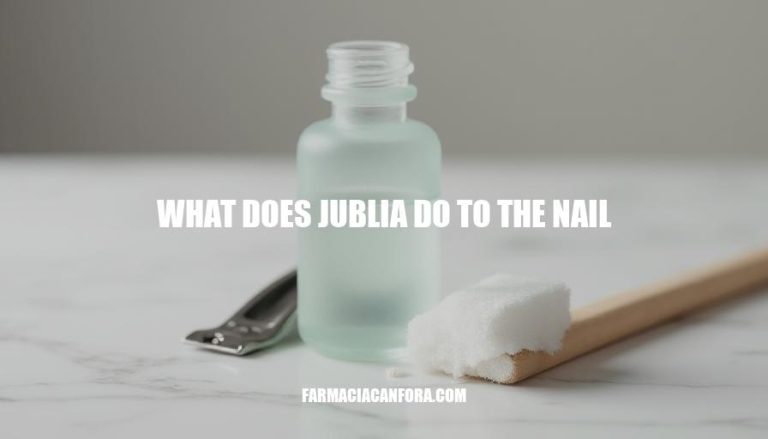


Jublia is a topical antifungal solution containing efinaconazole, designed to treat toenail fungal infections, specifically onychomycosis. It works by penetrating the nail to reach the site of infection, inhibiting the growth of the fungus and ultimately helping to clear the infection.
Jublia (efinaconazole) is a topical antifungal solution specifically designed to treat toenail fungus (onychomycosis). Here’s how it works on the nail:
Application: Jublia is applied directly to the affected toenail using a brush applicator. It is important to cover the entire nail, including the edges and underneath the nail, to ensure thorough treatment.
Penetration: The solution has a low surface tension, allowing it to spread easily and penetrate the nail plate. This helps Jublia reach the site of infection, which is often located in the nail bed and the undersurface of the nail.
Action on Fungal Cells: Jublia contains efinaconazole, an azole antifungal. Efinaconazole works by inhibiting the synthesis of ergosterol, a key component of fungal cell membranes. Without ergosterol, the fungal cell membranes become weak and unable to maintain their structure, leading to the death of the fungal cells.
Effects on the Nail: By eradicating the fungal infection, Jublia allows the nail to gradually return to a healthy state. Over time, as the fungus is eliminated, the nail can grow out normally without the discoloration, thickening, and brittleness caused by the infection.
Duration of Treatment: Jublia is typically applied once daily for 48 weeks. Consistent application is crucial for the treatment to be effective, as it ensures continuous exposure of the fungus to the antifungal agent.
In summary, Jublia works by penetrating the nail to reach the site of infection, disrupting the fungal cell membranes, and ultimately allowing the nail to heal and grow out healthy.
Here’s how to apply Jublia and what it does to the nail during application:
What Jublia Does:
Jublia (efinaconazole) is a topical solution used to treat fungal infections of the toenails. Here are some key data points and results from clinical studies:
Jublia works by inhibiting the growth of the fungus, allowing a clearer nail to grow back over time.
Here are the potential side effects of using Jublia (efinaconazole) on the nail:
These side effects are generally mild but should be reported to a healthcare provider if they persist or worsen.
Jublia is a topical antifungal solution that penetrates the nail to reach the site of infection, inhibiting fungal cell membranes and allowing the nail to heal and grow out healthy.
It works by applying the solution directly to the affected toenail using a brush applicator, covering the entire nail including edges and underneath. The solution has low surface tension, allowing it to spread easily and penetrate the nail plate.
Jublia contains efinaconazole, an azole antifungal that inhibits ergosterol synthesis in fungal cell membranes, leading to the death of fungal cells. By eradicating the fungal infection, Jublia allows the nail to gradually return to a healthy state, eliminating discoloration, thickening, and brittleness caused by the infection.
The treatment typically lasts 48 weeks, with consistent application crucial for effectiveness. Side effects are generally mild but may include irritation, pain, blisters, ingrown toenails, redness, swelling, itching, burning or stinging, and pain.
Jublia achieves a clinical cure rate of around 15-18% after 48 weeks, with approximately 54% achieving mycological cure and around 25% having nails that are almost clear or completely clear of infections after 11 months of treatment.